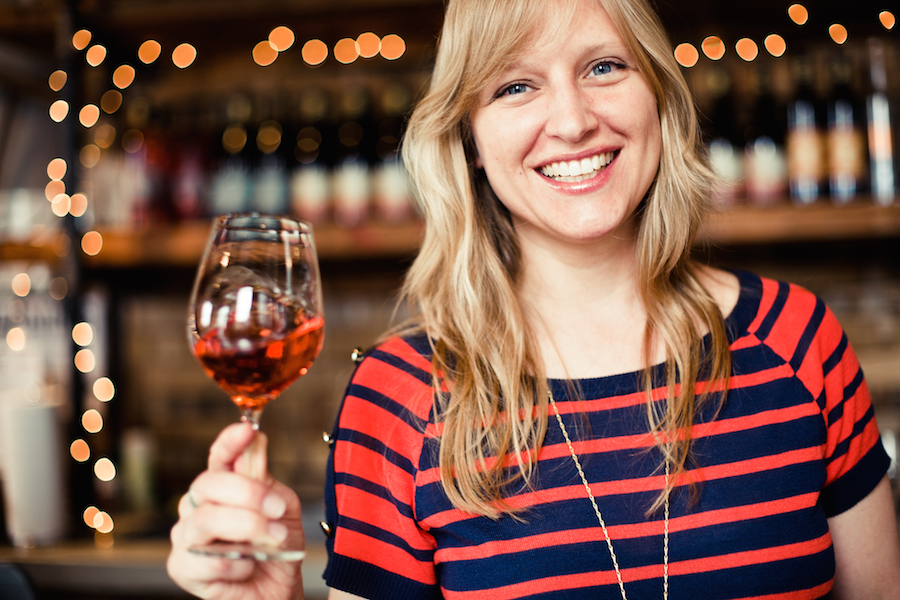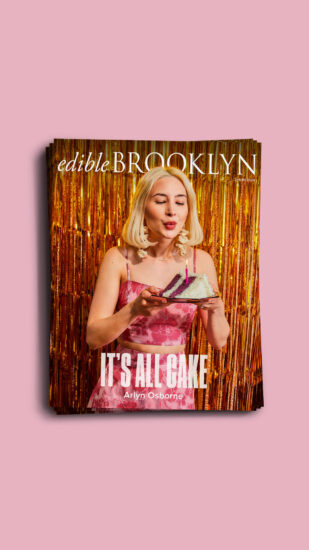If you’ve ever strolled through a vineyard, you’ve experienced the overwhelming urge to become a vintner. As you amble among the sun-dappled rows of vines, the wild smell of the earth hits your nostrils and inspires you to ditch it all, pack it up and somehow make wine your life’s work.
But for Alie Shaper, 38, that inspiration came in the last place anyone would expect to find her inner Greek goddess: the crumbling waterfront warehouses along Williamsburg’s Wythe Avenue. Where others see urban decay mingling with shiny, expensive modern condos, she saw the birth of Brooklyn Oenology.
“One weekend, I was looking at all these old warehouses and thinking about their history—how the city in part was built here, through longshoremen and welders and masons. I marveled at it, and at what the borough once stood for. [Today] these warehouses are filled with glassblowers, furniture makers, artisans of all kinds. And that’s when it hit me: ‘Oh my God, I could build a winery!’”
How did she go from vision to vino? Recalling her path, Shaper sits in the tasting room at the large wooden table that doubles as her off-hours desk. She absentmindedly but intently rubs her hands in large, slow circles on its worn planks, as if she’s rubbing, rubbing for the genie to come out of the bottle, only…she kind of is the genie.
Shaper is the kind of person who can make anything seem possible. If ConEd could harness her bright-eyed, seemingly unstoppable, utterly sincere brand of enthusiasm, they’d be onto the alter- native-energy jackpot. Her natural buzz makes the tale of the birth of BOE (that’s the B in Brooklyn, plus the OE in Oenology) sound like a breeze. That is, if you consider a decade-plus of planning and plotting and replotting and hard work and commitment breezy. The craft combines both sides of Shaper’s amazing brain. “Oenology is the art and science of making wine, but it’s such a neat word—a geek word! And, well…I am one.”
Raised in suburban Nassau County, Shaper was an artsy kid who also liked science, and since making a living in the creative world seemed more passing than plausible, she dove headlong into her other interest and became an engineer, landing a job out of college in Silicon Valley in 2000. Science is cause and effect, though, a realm where logic reigns—and while answers can be fulfilling, Shaper knew something was missing.
“My instinctual side wasn’t getting a voice, and I needed that in my everyday life.” She found it in wine country. On weekend trips with friends, she realized, “Wine is the perfect cross-section between science and art. When I discovered that other sensory part of life, a whole new world opened up for me.”
Shaper moved back to New York and began to indulge her newfound love. She got her hands on a sensory kit—a collection of little vials that contain different aromas—and sniffed and sniffed until the myriad, nuanced scents—black currant, rose, cedar, cherry, toast, butter, roasted nuts—started to transfix into her memory bank.
Then she saw an ad in the classifieds section of her local paper. “It said, ‘Do you love wine?’ And I said, ‘Well, yes I do!’” The ad, for a job at a Hudson Valley winery’s tasting-room, was placed by Bob Ransom, owner of the Rivendell Winery as well as Vintage, the two groundbreaking (now shuttered) Manhattan-based wine bars and stores that carried only New York vino.
Within six months of working for Ransom at Rivendell Winery and, later, in the SoHo outpost of Vintage, Shaper’s plans for BOE began to germinate.
She took the Advanced Certification course through the Wine & Spirits Education Trust. She worked weekends in a restaurant as a sommelier and learned how not just to think about and taste wine, but how to talk about it, too. “It’s a big subject, and it keeps you humble, but I found I was a natural at getting people excited,” she says, with a huge grin. By 2005, she was working full-time for the enormous importer Southern Wines & Spirits. “At first it was what I’d do when I retired!” she laughs, “but it just got closer and closer to my heart.”
By 2006, she was ready to dive into winemaking, and knew she wanted to learn from Russell Hearn. The owner of the Mattituck-based Premium Wine Group, a custom crush and winemaking facility, Hearn is the craftsman behind many of Long Island’s renowned producers who don’t have their own winemaking facilities. “I called him up and somehow convinced him I was a viable candidate to work there during the season.”
She knew that while there she could get things in place to launch her first BOE bottles. She worked in the lab, learning about phenolic compounds and acid levels, and the cellar, crushing and fermenting her way from juice to wine—anywhere she was needed and could get her hands into the part of the equation she needed to master. And with a seemingly endless stream of winemakers wandering around the place, she took the opportunity to ask questions, and learn.
Shaper did it all over again in 2007, and after that season, took the final leap and launched her first two wines, made from merlot juice she purchased from Long Island’s Pelligrini Vineyards and chardonnay from Castello di Borghese and the former Galluccio winery on the North Fork, and made at Premium Wine Group’s facilities, where she makes wine to this day.
“It was a really, really exciting and hectic time in my life,” she says. She put on her salesperson hat and began to get the BOE name out there, winning fans at the Greene Grape and even Gramercy Tavern, which took on the merlot—an elegant, refined ruby-gone-brick-hued red that smells like a bowl full of black cherries and blackberries, sassafras and that distinctive aroma of Long Island, dry earth.
That initial success gave her the rocket boost to expand from a few hundred bottles in 2007 to nearly 3,000 annually today. And last November, after five years of crafting her wines and selling them to city restaurants and shops, Shaper realized her original vision and opened the doors to a rustic wine-country-meets-urban-machinist tasting room in a centenarian-plus Williamsburg factory.
She designed the stainless, half-moon-shaped bar to resemble a fermenting tank, complete with an actual tank door welded onto it; a mish-mash of sturdy old metal and wooden stools skirt the rim. The walls behind it are a thatch-like pattern that Shaper and her boyfriend created using the staves of 12 old wine barrels they crowbarred apart and put back together, reforming the old pieces into what looks like an oversize basket weave. The diagonal slats of the wooden floor are original; the rough-hewn riddling rack she found in Epernay, France; the reclaimed-wood shelving holds wine from nine other New York producers.
The year after she released her initial two wines, she began experimenting with more grapes, creating blends that brought out their best attributes, like her red cuvée Motley Cru, a yearly changing blend of red varietals, or one of her latest additions, a soft and lively riesling from Finger Lakes grapes that’s all honeysuckles and juicy Crispin apples and great, balanced citrusy finish.
She created custom wines for clients like Big Tree in Bushwick (she makes their Roses Are Red rosé) and Scotto’s Wine Cellar in Carroll Gardens (for them, she makes three custom whites under their Harvey Estate label). And she began taking on side projects like Shindig, where she, two other winemakers and D.C. sommelier Andrew Stover make wines from lesser-known varietals, like Vidal Blanc, in part to turn imbibers on to new things and in part because it’s just fun.
And then there’s the art. “I didn’t want this to just be based in Brooklyn,” she explains. “I want it to be something that’s part of it; that celebrates it. That brings together the things I love about being here. We all draw inspiration from each other.”
With this in mind, her labels feature original paintings by borough artists; she changes them each vintage to give a new painter a chance to shine. She spends her off hours haunting small galleries and studios to find pieces that fit with her own notion of what she’s created yet also express the unique vision and style of the artist. “If something’s curated, they’re making it for you—I didn’t want that. I want the artwork to show the artist’s true vision. So it really represents what’s going on here.” Not to mention gives them a new platform for showing their work (which often also hangs on the BOE’s tasting room walls). And in what might be a wine-world first-ever, the labels peel off—allowing drinkers to, as the kids say, collect them all.
And now, after establishing herself as a successful wine producer, entrepreneur, patron of the arts, part-time gallery, and promoter of all-things artisanal from within New York borders (along with her own wine and that of nine other New York producers, she also sells locally made artisanal spirits, charcuterie, cheese, chocolate and myriad other willpower-slaying sundries), she’s got her eye on bringing the winemaking to Brooklyn, too: “That’s phase three.”
She admits it’s still a ways off—but then again, she initially saw BOE as her second-career retirement plan 30 years from now.
718-centric. “I didn’t want this to just be based in Brooklyn,” says BOE owner Alie Shaper. “I want it to be something that’s part of it; that celebrates it. That brings together the things I love about being here.”
Shaper worked as an engineer until she saw an ad in the classifieds section of the paper. “It said, ‘Do you love wine?’ And I said, ‘Well, yes I do!’”
Prize inside. BOE labels feature original paintings by borough artists. And in what might be a wine-world first-ever, the labels peel off—allowing drinkers to, as the kids say, collect them all.
Raising the bar. Last November, after five years of winemaking, Shaper opened a rustic tasting room in a century-old Williamsburg factory.
Photo credit: Noah Devereaux.



